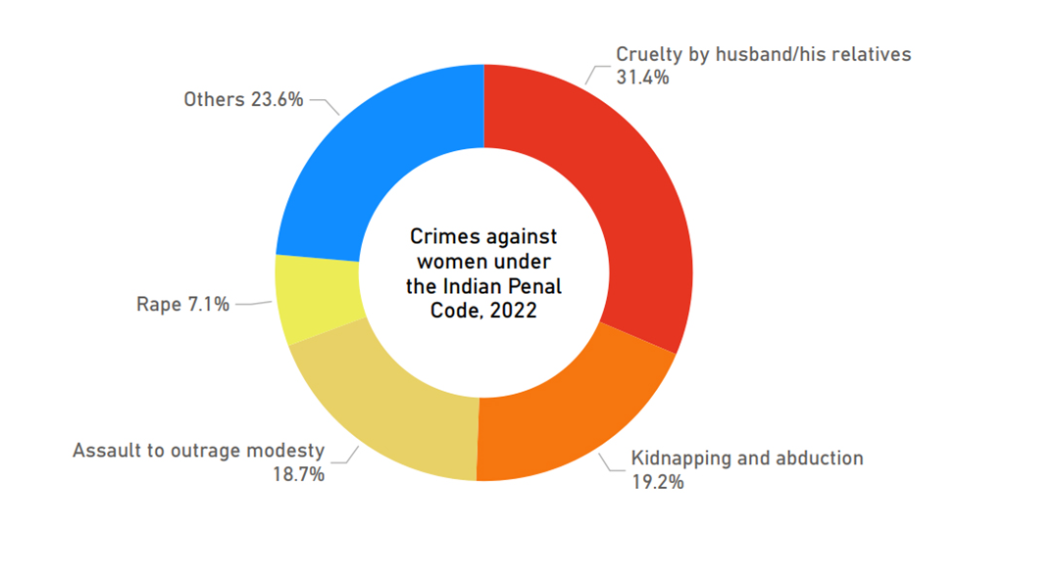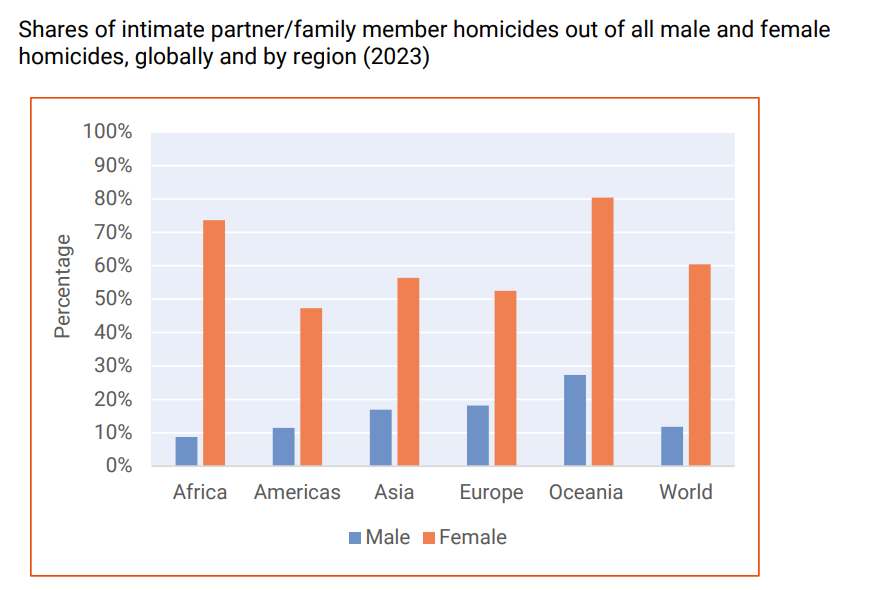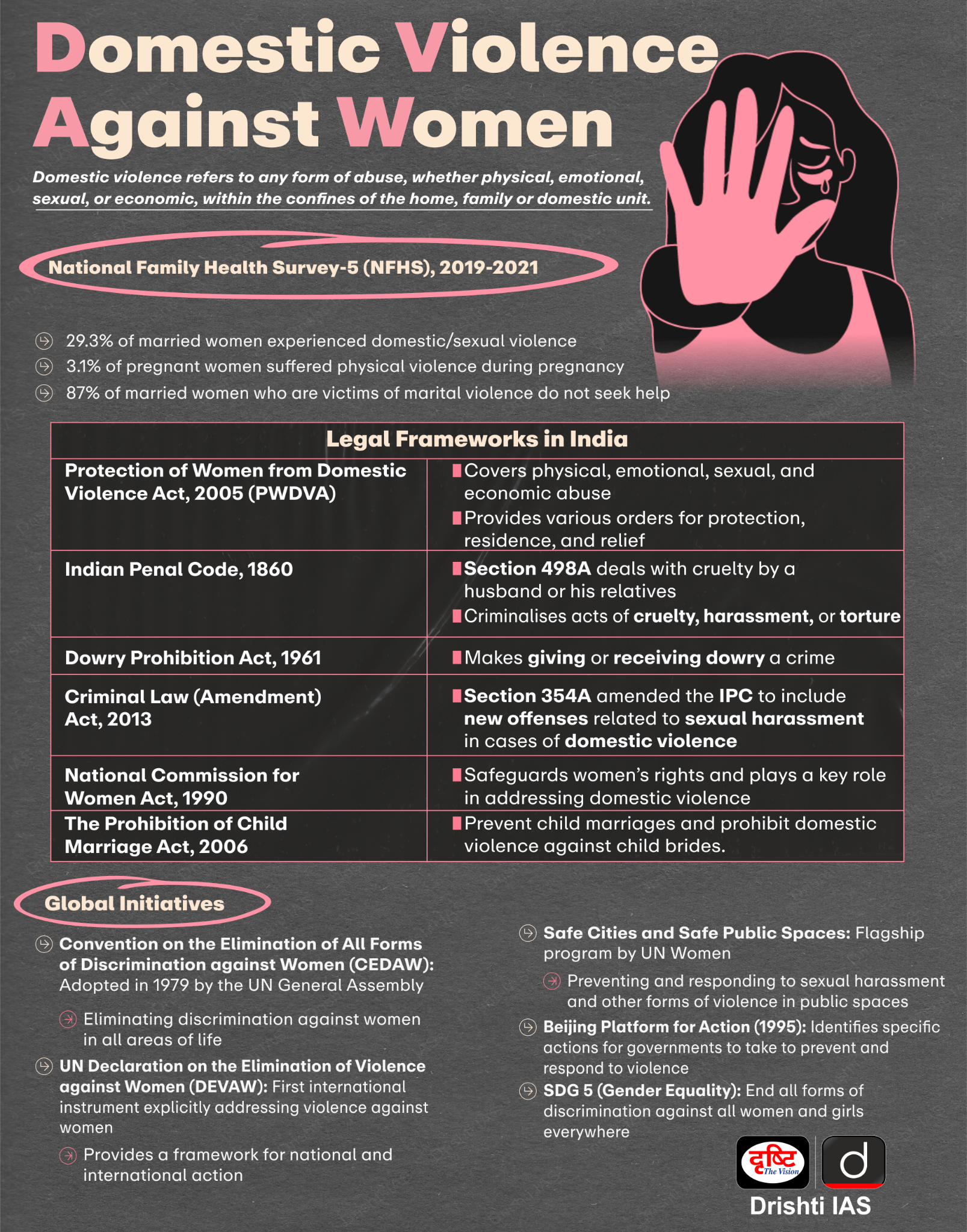Social Justice
Femicides in 2023: Global Estimates of Intimate Partner/Family Member Femicides Report
- 27 Nov 2024
- 12 min read
For Prelims: International Day for the Elimination of Violence against Women, UN Women, United Nations Office on Drugs and Crime (UNODC), National Crime Records Bureau 2022, United Nations General Assembly.
For Mains: Issues Related to women, Role of societal norms and women empowerment
Why in News?
Recently, the Femicides in 2023: Global Estimates of Intimate Partner/Family Member Femicides report was on the International Day for the Elimination of Violence against Women (25th November).
- It was released by UN Women and the United Nations Office on Drugs and Crime (UNODC) highlighting the severity of the global crisis of femicide.
- Femicide is defined as an intentional killing with a gender-related motivation. It is driven by discrimination against women and girls, unequal power relations, gender stereotypes or harmful social norms.
- It is different from homicide, where the motivation may not be gender-related.
What are the Key Findings of the Report?
- Global Scenario: In 2023, 85,000 women and girls were intentionally killed worldwide, with 60% (approximately 51,100) killed by intimate partners or family members.
- On average, 140 women and girls per day were victims of femicide by intimate partners or close relatives.
- Regional Disparities: Africa reported the highest number of victims (21,700) and the highest rate of femicide per population (2.9 per 100,000).
- The Americas and Oceania followed, with rates of 1.6 and 1.5 per 100,000, respectively, while Asia and Europe reported significantly lower rates, at 0.8 and 0.6 per 100,000.
- Non-Domestic Femicide: Non-domestic femicides are increasingly recognised. For instance, 5% of femicides in France (2019–2022) and 9% in South Africa (2020–2021) occurred outside domestic settings.
- Male as Homicide Victims: An estimated 80% of all homicide victims in 2023 were men while 20% were women.
- But, lethal violence impacts women more than men, with nearly 60% of women intentionally killed in 2023 being victims of intimate partner or family member homicide.
- Preventability of Femicide: A significant number of women killed by intimate partners had previously reported violence, including 22–37% in France (2019–2022) and similar trends in South Africa (2020–2021).
- Data and Availability: Data availability has declined, with only half as many countries reporting in 2023 as in 2020 (75 countries in 2020).
- Only a few countries collect data on non-domestic femicides using the UNODC-UN Women framework.
What are the Forms of Violence Against Women?
- Domestic Violence: It involves actions by a current or former partner, often a husband, or family members that cause physical, sexual, or emotional harm.
- Examples include physical aggression, coercion, psychological abuse, and controlling behaviours.
- Sexual Violence: It involves unwanted sexual acts imposed without consent, disproportionately targeting women and girls.
- Examples include rape, sexual harassment, online sexual abuse, non-contact sexual abuse, trafficking, and forced prostitution.
- In India, over 31,000 rape cases were reported in 2022, amounting to nearly 87 cases daily, as per the National Crime Records Bureau 2022.
- Psychological Abuse: It involves intimidation through looks, gestures, or shouting, as well as humiliation, obscene or derogatory comments, and public ridicule.
- It also includes practices like isolating menstruating women and female infanticide, which violate women’s rights and dignity.
- Cultural Abuse: It includes harmful social and cultural practices like female genital mutilation, witch-branding, child marriage, forced marriage, honour-based violence, and widowhood rituals.
- Technology-Facilitated Violence: It involves online defaming, harassment, stalking, cyberbullying, distribution of morphed and deepfake videos, and doxing (the release of private information about a woman publicly).
What are Key Facts Regarding Gender Violence in India?
- Increase in Crimes Against Women: According to the National Crime Records Bureau (NCRB) 2022 data, crimes against women rose 4% in 2022 compared to 2021.
- Nature of Crimes Against Women: The majority of crimes against women in 2022 were:

- Additionally, 13,479 cases were registered under the Dowry Prohibition Act, 1961
- Filing of FIRs: The NCRB’s report reveals that over 4.45 lakh cases of crimes against women were registered in 2022, equivalent to nearly 51 FIRs (first information report) every hour.
- High Rape Cases: There were more than 31,000 reported rapes in 2022. Rapes peaked at nearly 39,000 in 2016.
- In 2018, on average one woman reported a rape every 15 minutes across the country.
International Day for the Elimination of Violence Against Women
- About: It is observed on 25th November to raise awareness against violence against women and girls (VAWG).
- It was designated by the United Nations General Assembly in 1999.
- Honouring the Mirabal Sisters: The date honours the Mirabal Sisters (Patria, Minerva, and María Teresa) of the Dominican Republic, symbols of resistance against Rafael Trujillo's dictatorship and violence.
- On 25th November 1960, the sisters were assassinated by Trujillo’s orders.
United Nations Office on Drugs and Crime (UNODC)
- About: Founded in 1997, UNODC is a global leader in combating illicit drugs, international crime, and terrorism.
- Headquarters: It is located in Vienna with liaison offices in New York and Brussels.
- Terrorism Prevention: Expanded its activities in 2002 to assist states in ratifying and implementing universal legal instruments against terrorism.
UN Women
- About: UN Women is the UN entity aiming to address global gender inequality and empower women and girls.
- Creation: Established in July 2010 by the United Nations General Assembly as part of the UN reform agenda. It merged four existing UN entities.
- Division for the Advancement of Women (DAW)
- International Research and Training Institute for the Advancement of Women (INSTRAW)
- Office of the Special Adviser on Gender Issues and Advancement of Women (OSAGI)
- United Nations Development Fund for Women (UNIFEM)
- Key Goals: Eliminate discrimination against women and girls.
- Empower women and achieve equality between women and men.
- Promote gender equality in development, human rights, peace, and security.
What are the key Laws for Women’s Safety in India?
How to Prevent Femicide as per the Report?
- Addressing Root Causes: Focus on the root causes of gender-based violence at multiple levels.
- Individual Level: Address attitudes, behaviours, and histories of violence.
- Interpersonal Relationships: Improve family dynamics and partner interactions.
- Community Level: Strengthen organisational and community-based support systems.
- Societal Level: Challenge entrenched gender norms and stereotypes.
- Educational Initiatives: Integrate curricula to promote gender equality, relationship skills, and acceptable societal roles for men and women.
- Engage both genders in rethinking attitudes and behaviors that perpetuate violence.
- Legal Measures: Classify femicide as a distinct criminal offense, as done in Latin America, by adding aggravating factors for homicides driven by gender-based motives.
- Establish dedicated units within police, judiciary, and prosecution services for handling gender-based violence (e.g., Canada, Sweden, Jordan).
- Risk Reduction: Train police to identify high-risk situations and intervene promptly.
- Enforce orders preventing contact between perpetrators and victims and limit firearm access for individuals with histories of intimate partner violence to reduce the odds of killings.
- Awareness Movements: Campaigns like #MeToo and Ni Una Menos (Not one [woman] less in Argentina) to bring public attention to gender-based violence and condemn harmful practices.
- Data Collection and Analysis: Governments should produce annual reports on femicide trends and patterns.
- Civil Society should establish "femicide observatories" to monitor and analyse data from multiple sources.
Conclusion
The report highlights the global crisis of femicide, urging a multifaceted approach to combat gender-based violence. Prevention requires addressing root causes, strengthening legal frameworks, increasing public awareness, and improving data collection. Collective action across individual, societal, and institutional levels is essential to curb femicide and protect women's rights.
|
Drishti Mains Question: Examine the root causes of gender-based violence and propose strategies to prevent femicide in India. |
UPSC Civil Services Examination, Previous Year Questions (PYQs)
Prelims
Q. ‘Beijing Declaration and Platform for Action’, often seen in the news, is (2015)
(a) a strategy to tackle the regional terrorism, an outcome of a meeting of the Shanghai Cooperation Organization
(b) a plan of action for sustainable economic growth in the Asia-Pacific Region, an outcome of the deliberations of the Asia-Pacific Economic Forum
(c) an agenda for women’s empowerment, an outcome of a World Conference convened by the United Nations
(d) a strategy to combat wildlife trafficking, a declaration of the East Asia Summit
Ans: (c)
Mains
Q. We are witnessing increasing instances of sexual violence against women in the country. Despite existing legal provisions against it, the number of such incidences is on the rise. Suggest some innovative measures to tackle this menace. (2014)
Q. Male membership needs to be encouraged in order to make women’s organization free from gender bias. (2013)






